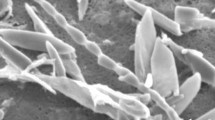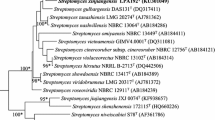Abstract
A novel Streptomyces strain, MUSC 119T, was isolated from a soil collected from a mangrove forest. Cells of MUSC 119T stained Gram-positive and formed light brownish grey aerial mycelium and grayish yellowish brown substrate mycelium on ISP 2 medium. A polyphasic approach was used to determine the taxonomic status of strain MUSC 119T, which shows a range of phylogenetic and chemotaxonomic properties consistent with those of the genus Streptomyces. The cell wall peptidoglycan consisted of ll-diaminopimelic acid. The predominant menaquinones were identified as MK-9(H8), MK-9(H6) and MK-9(H4). The polar lipid profile consisted of phosphatidylinositol, phosphatidylethanolamine, glycolipids, diphosphatidylglycerol and four phospholipids. The predominant cellular fatty acids were anteiso-C15:0, iso-C16:0, and anteiso-C17:0. The cell wall sugars were glucose, mannose, ribose and rhamnose. The phylogenetic analysis based on 16S rRNA gene sequence similarity showed that strain MUSC119T to be closely related to Streptomyces rhizophilus JR-41T (99.0 % sequence similarity), S. panaciradicis 1MR-8T (98.9 %), S. gramineus JR-43T (98.8 %) and S. graminisoli JR-19T (98.7 %). These results suggest that MUSC 119T should be placed within the genus Streptomyces. DNA–DNA relatedness values between MUSC 119T to closely related strains ranged from 14.5 ± 1.3 to 27.5 ± 0.7 %. The G+C content was determined to be 72.6 mol %. The polyphasic study of MUSC 119T showed that this strain represents a novel species, for which the name Streptomyces humi sp. nov. is proposed. The type strain of S. humi is MUSC 119T (=DSM 42174T = MCCC 1K00505T).

Similar content being viewed by others
References
Atlas RM (1993) In: Parks LC (ed) Handbook of microbiological media. CRC Press, Boca Raton
Azman A-S, Othman I, Velu SS, Chan K-G, Lee L-H (2015) Mangrove rare actinobacteria: taxonomy, natural compound, and discovery of bioactivity. Front Microbiol 6:856
Bérdy J (2005) Bioactive microbial metabolites. J Antibiot 58:1–26
Carillo P, Mardarz C, Pitta-Alvarez S (1996) Isolation and selection of biosurfactant producing bacteria. World J Microbiol Biotechnol 12:82–84
Cashion P, Holder-Franklin MA, McCully J, Frankiln M (1977) A rapid method for the base ratio determination of bacterial DNA. Anal Biochem 81:461–466
Cerny G (1978) Studies on aminopeptidase for the distinction of Gram-negative from Gram-positive bacteria. Eur J Appl Microbiol Biotechnol 5:113–122
De Ley J, Cattoir H, Reynaerts A (1970) The quantitative measurement of DNA hybridization from renaturation rates. Eur J Biochem 12:133–142
Felsenstein J (1981) Evolutionary trees from DNA sequences: a maximum likelihood approach. J Mol Evol 17:368–376
Felsenstein J (1985) Confidence limits on phylogenies: an approach using the bootstrap. Evolution 39:783–789
Hain T, Ward-Rainey N, Kroppenstedt RM, Stackebrandt E, Rainey FA (1997) Discrimination of Streptomyces albidoflavus strains based on the size and number of 16S-23S ribosomal DNA intergenic spacers. Int J Syst Bacteriol 47:202–206
Hong K, Gao AH, Xie QY, Gao H, Zhuang L, Lin HP, Yu HP, Li J, Yao XS, Goodfellow M, Ruan JS (2009) Actinomycetes for marine drug discovery isolated from mangrove soils and plants in China. Mar Drugs 7:24–44
Hu H, Lin H-P, Xie QY, Li L, Xie XQ, Sun M, Hong K (2011) Streptomyces shenzhenensis sp. nov., a novel actinomycete isolated from mangrove sediment. Antonie Van Leeuwenhoek 100:631–637
Hu H, Lin H-P, Xie QY, Li L, Xie XQ, Hong K (2012) Streptomyces qinglanensis sp. nov., isolated from mangrove sediment. Int J Syst Evol Microbiol 62:596–600
Jennerjahn TC, Ittekkot V (2002) Relevance of mangroves for the production and deposition of organic matter along tropical continental margins. Naturwissenschaften 89:23–30
Kates M (1986) Techniques of lipidology, 2nd edn. Elsevier, Amsterdam
Kelly KL (1964) Inter-society color council-national bureau of standards color name charts illustrated with centroid colors. US Government Printing Office, Washington, DC
Kim OS, Cho YJ, Lee K, Yoon SH, Kim M, Na H, Park SC, Jeon YS, Lee JH, Yi H, Won S, Chun J (2012) Introducing EzTaxon-e: a prokaryotic 16S rRNA gene sequence database with phylotypes that represent uncultured species. Int J Syst Evol Microbiol 62:716–721
Kimura M (1980) A simple method for estimating evolutionary rates of base substitutions through comparative studies of nucleotide sequences. J Mol Evol 16:111–120
Küster E, Williams ST (1964) Media for the isolation of Streptomycetes: starch casein medium. Nature 202:928–929
Lechevalier MP, Lechevalier H (1970) Chemical composition as a criterion in the classification of aerobic actinomycetes. Int J Syst Bacteriol 20:435–443
Lee H-J, Whang K-S (2014) Streptomyces graminisoli sp. nov. and Streptomyces rhizophilus sp. nov., isolated fri bamboo (Sasa borealis) rhizophere soil. Int J Syst Evol Microbiol 64:1546–1551
Lee H-J, Han S-I, Whang K-S (2012) Streptomyces gramineus sp. nov., an antibiotic-producing actinobacterium isolated from bamboo (Sasa borealis) rhizosphere soil. Int J Syst Evol Microbiol 62:856–859
Lee L-H, Azman A-S, Zainal N, Eng S-K, Ab Mutalib N-S, Yin W-F, Chan K-G (2014a) Microbacterium mangrovi sp. nov., an amylotytic actinobacterium isolated from mangrove forest soil. Int J Syst Evol Microbiol 64:3513–3519
Lee L-H, Azman A-S, Zainal N, Eng S-K, Fang C-M, Hong K, Chan K-G (2014b) Novosphingobium malaysiense sp. nov. isolated from mangrove sediment. Int J Syst Evol Microbiol 64:1194–1201
Lee L-H, Zainal N, Azman A-S, Ab Mutalib N-S, Hong K, Chan K-G (2014c) Mumia flava gen. nov., sp. nov., an actinobacterium of the family Nocardioidaceae. Int J Syst Evol Microbiol 64:1461–1467
Lee L-H, Zainal N, Azman A-S, Eng S-K, Ab Mutalib N-S, Yin W-F, Chan K-G (2014d) Streptomyces pluripotens sp. nov., a bacteriocin-producing streptomycete that inhibits meticillin-resistant Staphylococcus aureus. Int J Syst Evol Microbiol 64:3297–3306
Lee L-H, Zainal N, Azman A-S, Eng S-K, Goh B-H, Yin W-F, Ab Mutalib N-S, Chan K-G (2014e) Diversity and antimicrobial activities of actinobacteria isolated from tropical mangrove sediments in Malaysia. Sci World J 2014:14
MacFaddin JF (2000) Biochemical Tests for Identification of Medical Bacteria, 3rd edn. Baltimore, Lippincott, Williams and Wilkins
Meena B, Rajan LA, Vinithkumar NV, Kirubagaran R (2013) Novel marine actinobacteria from emerald Andaman & Nicobar Islands: a prospective source for industrial and pharmaceutical byproducts. BMC Microbiol 13:145
Mesbah M, Premachanran U, Whitman WB (1989) Precise measurement of the G+C content of deoxyribonucleic acid by high-performance liquid chromatography. Int J Syst Bacteriol 39:159–167
Saitou N, Nei M (1987) The neighbour-joining method: a new method for reconstructing phylogenetic tree. Mol Biol Evol 4:406–425
Sasser M (1990) Identification of bacteria by gas chromatography of cellular fatty acids, MIDI technical note 101. MIDI Inc, Newark
Schumann P (2011) Peptidoglycan structure. Methods Microbiol 38:101–129
Ser H-L, Zainal N, Palanisamy UD, Goh B-H, Yin W-F, Chan K-G, Lee L-H (2015a) Streptomyces gilvigriseus sp. nov., a novel actinobacterium isolated from mangrove forest soil. Antonie Van Leeuwenhoek 107:1369–1378
Ser H-L, Palanisamy UD, Yin W-F, Abd Malek SN, Chan K-G, Goh B-H, Lee L-H (2015b) Presence of antioxidative agent, Pyrrolo[1,2-a]pyrazine-1,4-dione,hexahydro- in newly isolated Streptomyces mangrovisoli sp. nov. Front Microbiol 6:854
Shirling EB, Gottlieb D (1966) Methods for characterization of Streptomyces species. Int J Syst Bacteriol 16:313–340
Staneck JL, Roberts GD (1974) Simplified approach to identification of aerobic actinomycetes by thin-layer chromatography. Appl Microbiol 28:226–231
Sui J-L, Xu X-X, Qu Z, Wang H-L, Lin H-P, Xie Q-Y, Ruan J-S, Hong K (2011) Streptomyces sanyensis sp. nov., isolated from mangrove sediment. Int J Syst Evol Microbiol 61:1632–1637
Takahashi Y, Matsumoto A, Seino A, Iwai Y, Omura S (1996) Rare actinomycetes isolated from desert soils. Actinomycetologica 10:91–97
Tamura K, Peterson D, Peterson N, Stecher G, Nei M, Kumar S (2011) MEGA5: molecular evolutionary genetics analysis using maximum likelihood, evolutionary distance, and maximum parsimony method. Mol Biol Evol 28:2731–2739. doi:10.1093/molbev/mst197
Thompson JD, Gibson TJ, Plewniak F, Jeanmougin F, Higgins DG (1997) The Clustal X windows interface: flexible strategies for multiple sequence alignment aided by quality analysis tools. Nucleic Acids Res 25:4876–4882
Versalovic J, Koeuth T, Lupski JR (1991) Distribution of repetitive DNA sequences in eubacteria and application to fingerprinting of bacterial genomes. Nucleic Acids Res 19:6823–6831
Waksman SA, Henrici AT (1943) The nomenclature and classification of the actinomycetes. J Bacteriol 46:337–341
Wayne LG, Brenner DJ, Colwell RR, Grimont PAD, Kandler O, Krichevsky MI, Moore LH, Moore WEC, Murray RGE, Stackebrandt E et al (1987) Report of the Ad Hoc committee on reconciliation of approaches to bacterial systematics. Int J Syst Bacteriol 37:463–464
Whiton RS, Lau P, Morgan SL, Gilbart J, Fox A (1985) Modifications in the alditol acetate method for analysis of muramic acid and other neutral and amino sugars by capillary gas chromatography-mass spectrometry with selected ion monitoring. J Chromatogr A 347:109–120. doi:10.1016/S0021-9673(01)95474-3
Williams ST, Goodfellow M, Alderson G (1989) Genus Streptomyces Waksman and Henrici 1943, 339AL. In: Williams ST, Sharpe ME, Holt JG (eds) Bergey’s manual of systematic bacteriology. Williams & Wilkins, Baltimore, pp 2452–2492
Xiao J, Wang Y, Xie S-J, Ruan J-S, Xu J (2009) Streptomyces avicenniae sp. nov., a novel actinomycete isolated from the rhizosphere of the mangrove plant Avicennia mariana. Int J Syst Evol Microbiol 59:2624–2628
Xu J, Wang Y, Xie S-J, Xu J, Xiao J, Ruan J-S (2009) Streptomyces xiamenensis sp. nov., isolated from mangrove sediment. Int J Syst Evol Microbiol 59:472–476
Zhang BH, Cheng J, Li L, Zhang YG, Wang HF, Li HQ, Yang JY, Li WJ (2014) Strreptomyces jiujiangensis sp. nov., isolated from soil in South China. Antonie Van Leeuwenhoek 105:763–770
Acknowledgments
This work was supported by the University of Malaya for High Impact Research Grant (UM-MOHE HIR Nature Microbiome Grant No. H-50001-A000027 and No. A000001-50001) awarded to K.-G. C. and External Industry Grant (Biotek Abadi-Vote No. GBA-808138), Fundamental Research Grant Scheme (FRGS/1/2013/SKK01/MUSM/03/3), MOSTI ScienceFund Grant (Project No. 06-02-10-SF0300) awarded to L.-H. L. Authors are grateful to Dr Jean Euzéby for the support in the Latin etymology of the new species name.
Author information
Authors and Affiliations
Corresponding author
Electronic supplementary material
Below is the link to the electronic supplementary material.
Rights and permissions
About this article
Cite this article
Zainal, N., Ser, HL., Yin, WF. et al. Streptomyces humi sp. nov., an actinobacterium isolated from soil of a mangrove forest. Antonie van Leeuwenhoek 109, 467–474 (2016). https://doi.org/10.1007/s10482-016-0653-1
Received:
Accepted:
Published:
Issue Date:
DOI: https://doi.org/10.1007/s10482-016-0653-1




